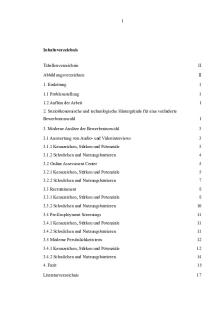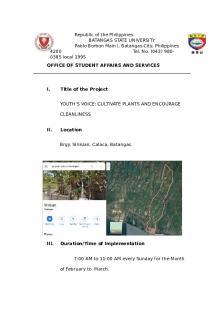AR 333 Mock Project Proposal Final PDF

| Title | AR 333 Mock Project Proposal Final |
|---|---|
| Author | Michael Maugeri |
| Course | Archaeology of Disasters [14] |
| Institution | Wilfrid Laurier University |
| Pages | 7 |
| File Size | 272.9 KB |
| File Type | |
| Total Downloads | 25 |
| Total Views | 159 |
Summary
AR course...
Description
Michael Maugeri Dr. Gallimore AR 333 2/10/2020
1
AR333 - Mock Project Proposal The Pompeii(s) Beneath Pompeii The site of Pompeii in Naples, Italy, was founded in the 6th or 7th century BCE and is famously known for its destruction in association with the eruption of the volcanic Mt. Vesuvius in 79 AD. (Cooley, 2004:5) Almost all the excavations of this site and neighboring areas have only been concerned with the time of the eruption, excavating no further than the ground level of 79 AD. (Gallimore, 2020) This project aims to provide a glimpse into the previous Pompeii’s that lie under the Pompeii we know today. With several hundred years of history pre-dating the destruction of the site, there is bound to be an abundance of data that can shine a light into the development and earlier years of this famous Roman city. This will be employed by excavating a previously unexcavated area, but also a location that is surrounded by areas that have been subject to intense previous excavation. Interpretations can then be made in relation to the previous research. This will allow for a ‘bigger picture’ of the site to be uncovered, relating the findings to the data from previous excavations. One could also look at the known history of Pompeii in relation to the findings of the project to correct misinformation. Furthermore, this could provide insight into the development of this famous site and how it came to be the city that was destroyed in 79 AD. This project could potentially provide knowledge into the people of Pompeii’s perception of Mt. Vesuvius: Were they aware it was an active volcano? Had they dealt with its eruptions before the eruption of 79 AD? Why would people have stayed at the site, only to fall victim to the destruction? These questions are going to be the focus of the project.
Michael Maugeri Dr. Gallimore AR 333 2/10/2020
2
Description and Background The objective of this project is to explore the history of the site of Pompeii past the levels of destruction from 79 AD. This project is going to explore the several hundred years of history Pompeii possessed prior to its destruction, allowing for an in-depth research project of a wellknown site, yet taking a new approach. This will contribute to expanding knowledge about the site of Pompeii over a longer period rather than simply exploring a time period that has already been the subject of decades and decades of excavation and research. Although not an entirely new idea, studies with similar objectives to the one proposed here have been conducted in the past, but not many. Paolo Carafa established that the earliest settlements within the Pompeii area have received little attention by scholars and have in turn been the subject of very few studies.1 Carafa specifically attempts to reconstruct the evolution of the building techniques employed at Pompeii between the sixth and second centuries BC. In another report by Filippo Coarelli, it is stated that less than 2% of the entire settlement of Pompeii has been investigated below the level of 79 AD.2 Thus, it is very apparent that a study such as the one proposed in this paper will be incredibly beneficial to the knowledge of Pompeii and Roman society, as it will be focusing on an area where there is a known lack of knowledge and understanding. This project will provide insight into unexplored areas of Pompeii’s history, potentially adding to a greater understanding of Roman settlements. This project will consist of excavations within the unexcavated Regio 1 of the site of Pompeii. (See Image 1) The map provided is an overview of the site of Pompeii and 1
Carafa, Paolo. “Recent Work on Early Pompeii.” The World of Pompeii, 2007, 63.
2
Coarelli, Filippo, and Fabrizio Coarelli. “The Urban Development of NW Pompeii: The Archaic Period to the 3rd.
c. BC.” Journal of Roman Archaeology, 2011, 37.
Michael Maugeri Dr. Gallimore AR 333 2/10/2020
3
identifies the several portions of the site that have not yet been excavated and which portions have been excavated. This area, Regio 1, has been selected as the optimal location for this excavation project as it is in the middle of several complexes that have already been subject to excavation and research, yet remains untouched itself. This will allow for the data gathered to be viewed in a comparative manner in relation to the knowledge of the excavated surrounding areas. Being a project performed in 2020, this will be an attempt at a ‘paper-less’ project. All recording in-field will take place with computers or tablets. Pictures will be used intensively as well. Infield drawings will be supplemented with drawing technologies such as tablets with styluses. The site will be first analyzed with GPR technologies in order to most effectively place several large trenches. Based on the data recovered from the initial trenches, specific units will be opened throughout Regio 1. Overall this project will be an attempt at uncovering past settlement patterns as well as exploring the little-known societies that inhabited the area prior to its destruction in 79 AD.
Methodology The chosen area for excavation is Regio 1 for several reasons. Primarily it is a smaller portion of the unexcavated areas within the site of Pompeii, this will allow for a significant future for similar projects to be undertaken considering the results of this project. This project will utilize GPR technology to first locate areas for large trenches to be dug. This will allow for any anomalies such as potential structures to be located. Upon excavating these large trenches, based on the information gathered through them and the GPR survey, smaller units of excavation will be opened in a dispersed manner. This will allow for a large area to be researched in a very
Michael Maugeri Dr. Gallimore AR 333 2/10/2020
4
organized manner. Additionally, this excavation will be an attempt at a ‘paper-less’ project in which the use of technologies will be intensive. Computers and tablets are to supplement paper notes as well as drawings. This can additionally allow for an element of communication that can only be obtained through the use of various technologies. Data will be able to be shared between anyone working within the site instantly. If connections remain functional, this opens the door for in-field analysis and interpretations to be made more accurately, which has the potential to minimize the amount of work done outside the field as well. Being performed in an unexcavated area of Pompeii, this project will have a stronger focus on the data recovered from below stratigraphic levels of 79 AD. However, this project will also allow for an analysis of the time of the eruption of Mt. Vesuvius with modern technology and has the potential to contribute to knowledge in that area as well.
Expected Outcomes It is expected that this project will uncover evidence of past experience with volcanic activity from Mt. Vesuvius, whether it be evidence of the destruction that pre-dates the eruption of 79 AD or evidence that suggests the community was aware that the mountain was an active volcano and what exactly it was capable of. It is also expected that this project will uncover past settlement patterns and data that allows for vast interpretations of the culture that existed within the site prior to its destruction. This project has the potential for research to explore an area of the great history that has not been uncovered yet. Hundreds of years of history lie below the stratigraphic levels of 79 AD and this project aims to explore what they have to offer.
Michael Maugeri Dr. Gallimore AR 333 2/10/2020
5
Knowledge Mobilization Upon completion of this project, a report will be published online and made accessible to the public for free. There will be presentations and panels held at various conferences in the following months displaying the project’s findings and results. A website will be made during the project and updates will be posted regularly to keep stakeholders and the public in the know and up to date on what is happening with the project. All the digitized and recorded material from the project’s excavations will also be archived and made public information on the website. Finally, the website will consist of a public forum in which anyone can discuss and offer interpretations on any aspect of the project.
Michael Maugeri Dr. Gallimore AR 333 2/10/2020
6
Images
Image 1. A Map of Pompeii, with indications of which regions or regio have been excavated and which have not.
Michael Maugeri Dr. Gallimore AR 333 2/10/2020
7
Bibliography Carafa, Paolo. “Recent Work on Early Pompeii.” The World of Pompeii, 2007, 63–69. Coarelli, Filippo, and Fabrizio Coarelli. “The Urban Development of NW Pompeii: The Archaic Period to the 3rd. c. BC.” Journal of Roman Archaeology, 2011, 37–58....
Similar Free PDFs

Final Project Proposal
- 11 Pages

Final YEAR Project Proposal
- 12 Pages

Final Project Proposal
- 7 Pages

Final NSTP Project Proposal
- 13 Pages

Project proposal semi final
- 12 Pages

Wi Ar 190503 final
- 16 Pages

AR 312 RM RESEARCH PROPOSAL
- 17 Pages

Mock Final Exam - Questions
- 11 Pages

Project Proposal
- 3 Pages

project proposal
- 7 Pages

Project Proposal
- 1 Pages

Project Proposal
- 16 Pages

PROPOSAL PROJECT
- 1 Pages
Popular Institutions
- Tinajero National High School - Annex
- Politeknik Caltex Riau
- Yokohama City University
- SGT University
- University of Al-Qadisiyah
- Divine Word College of Vigan
- Techniek College Rotterdam
- Universidade de Santiago
- Universiti Teknologi MARA Cawangan Johor Kampus Pasir Gudang
- Poltekkes Kemenkes Yogyakarta
- Baguio City National High School
- Colegio san marcos
- preparatoria uno
- Centro de Bachillerato Tecnológico Industrial y de Servicios No. 107
- Dalian Maritime University
- Quang Trung Secondary School
- Colegio Tecnológico en Informática
- Corporación Regional de Educación Superior
- Grupo CEDVA
- Dar Al Uloom University
- Centro de Estudios Preuniversitarios de la Universidad Nacional de Ingeniería
- 上智大学
- Aakash International School, Nuna Majara
- San Felipe Neri Catholic School
- Kang Chiao International School - New Taipei City
- Misamis Occidental National High School
- Institución Educativa Escuela Normal Juan Ladrilleros
- Kolehiyo ng Pantukan
- Batanes State College
- Instituto Continental
- Sekolah Menengah Kejuruan Kesehatan Kaltara (Tarakan)
- Colegio de La Inmaculada Concepcion - Cebu


